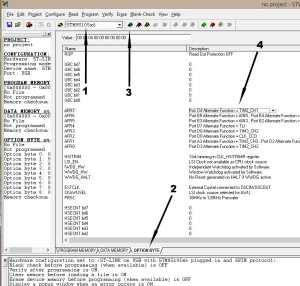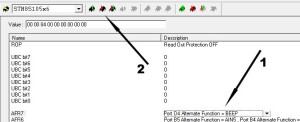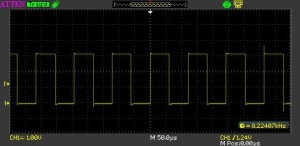STM8S Beep Function
The beep function uses the 128 KHz LSI to generate a beep signal on the beep pin of the STM8S. This post demonstrates how to use this function.
Hardware
The signal is output on the beep pin. On the STM8S discovery board this is an alternative function on PD4 (port D, pin 4).
Setting the Alternative Function
The alternative functions are assigned to a pin by reprogramming the option bytes. This can be performed using the ST Visual Programmer. Start this application and read the option bytes from the STM8S:
- Select the STM8S model. On the STM8S Discovery board this is STM8S105C6
- Select the OPTION BYTE tab
- Read the option bytes from the microcontroller
- Check the value of the AFR7 bit
AFR7 needs to be set to Port D4 Alternative Function = BEEP on the STM8S Discovery board. This may be different on your STM8S so check the documentation for your microcontroller. To set the alternative function to beep:
- Select Port D4 Alternative Function = BEEP from the list of values in the alternative functions
- Write the option bytes back to the microcontroller
The beep function should now be assigned to PD4.
Registers
The beep function is controlled by three registers:
- BEEP_CSR_BEEPSEL
- BEEP_CSR_BEEPDIV
- BEEP_CSR_BEEPEN
Beep Selection – BEEP_CSR_BEEPSEL
These bits set the multiplier for the Beep Divider.
| BEEP_CSR_BEEPSEL | Frequency (KHz) |
| 0 | fLSI / (8 * BEEPDIV) |
| 1 | fLSI / (4 * BEEPDIV) |
| 2 or 3 | fLSI / (2 * BEEPDIV) |
Beep Divider – BEEP_CSR_BEEPDIV
Value for the prescalar divider.
BEEPDIV = 2 + BEEP_CSR_BEEPDIV
The documentation states that this should not be left set to the reset value (0x1f) and the value should be in the range 0 – 0x1e.
Beep Enable – BEEP_CSR_BEEPEN
Enable the beep function by setting this to 1, disable by setting this to 0.
Software
We start by providing a method for resetting the system clock to use the HSI:
//
// This program demonstrates how to use the beep function on the STM8S
// microcontroller.
//
// This software is provided under the CC BY-SA 3.0 licence. A
// copy of this licence can be found at:
//
// http://creativecommons.org/licenses/by-sa/3.0/legalcode
//
#include <iostm8S105c6.h>
#include <intrinsics.h>
//--------------------------------------------------------------------------------
//
// Setup the system clock to run at 16MHz using the internal oscillator.
//
void InitialiseSystemClock()
{
CLK_ICKR = 0; // Reset the Internal Clock Register.
CLK_ICKR_HSIEN = 1; // Enable the HSI.
CLK_ECKR = 0; // Disable the external clock.
while (CLK_ICKR_HSIRDY == 0); // Wait for the HSI to be ready for use.
CLK_CKDIVR = 0; // Ensure the clocks are running at full speed.
CLK_PCKENR1 = 0xff; // Enable all peripheral clocks.
CLK_PCKENR2 = 0xff; // Ditto.
CLK_CCOR = 0; // Turn off CCO.
CLK_HSITRIMR = 0; // Turn off any HSIU trimming.
CLK_SWIMCCR = 0; // Set SWIM to run at clock / 2.
CLK_SWR = 0xe1; // Use HSI as the clock source.
CLK_SWCR = 0; // Reset the clock switch control register.
CLK_SWCR_SWEN = 1; // Enable switching.
while (CLK_SWCR_SWBSY != 0); // Pause while the clock switch is busy.
}
The next task is to configure the beep function:
//--------------------------------------------------------------------------------
//
// Initialise the Beep function.
//
void InitialiseBeep()
{
BEEP_CSR_BEEPEN = 0; // Turn off the beep.
BEEP_CSR_BEEPSEL = 0; // Set beep to fls / (8 * BEEPDIV) KHz.
BEEP_CSR_BEEPDIV = 0; // Set beep divider to 2.
BEEP_CSR_BEEPEN = 1; // Re-enable the beep.
}
The final piece of code is the main program loop. This sets up the clock and the beep function:
//--------------------------------------------------------------------------------
//
// Main program loop.
//
void main()
{
//
// Initialise the system.
//
__disable_interrupt();
InitialiseSystemClock();
InitialiseBeep();
__enable_interrupt();
//
// Main program loop.
//
while (1)
{
__halt();
}
}
Compiling this code and deploying to the STM8S results in the following trace on the oscilloscope:
As you can see, the output is not exactly 8KHz.
Conclusion
The documentation states that the beep function can generate 1KHz, 2KHz and 4KHz. By changing the values of the prescalar and the selection register it appears that you can also go as low as 500Hz and as high as 32KHz.
Tags: Electronics, Software Development, STM8, The Way of the Register
Tuesday, July 1st, 2014 at 1:00 am • Electronics, Software Development, STM8 • RSS 2.0 feed Both comments and pings are currently closed.



